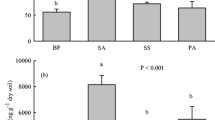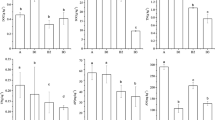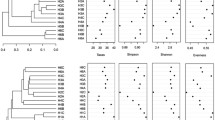Abstract
The practice of wetland mitigation has come into question during the past decade because the relative capacity of the mitigated wetlands to perform normal wetland functions is mostly unknown. In this study, we wanted to determine whether soil microbial communities were significantly different in early successional mitigated wetlands (<10 years) (ES) compared to late successional bottomland hardwood forest wetlands (LS) due to differences in soil properties, such as carbon quality and storage and water-holding capacity. Carbon storage in litter and soil was 1.5 times greater in LS wetlands than ES wetlands. Soil water-holding capacity was significantly greater in LS wetlands and was related to soil organic C content (r 2=0.87, p-value=0.0007). Gravimetric water content was a moderately strong predictor of microbial respiration (r 2=0.55-0.61, p-value=0.001-0.0004) and microbial biomass (r 2=0.70, p-value=0.0019). Anaerobic microbial groups were enriched in soils from LS wetlands in both the dry and wet seasons, which suggested that LS soils were wetter for longer periods of the year than ES soils. The capacity of these wetlands to support anaerobic microbial processes depends on soil water retention characteristics, which were dictated by organic matter content. As an integrator of microbial growth conditions in soils, determination of microbial community composition by phospholipid fatty acid (PLFA) analysis may be an important new tool for monitoring successional development of compensatory mitigation wetlands.
Similar content being viewed by others
Literature cited
Ainslie, W. B., R. D. Smith, B. A. Pruitt, T. H. Roberts, E. J. Sparks, L. West, G. L. Godshalk, and M. V. Miller. 1999. A regional guidebook for assessing the functions of low gradient, riverine wetlands in western Kentucky. U. S. Army Engineer Waterways Experiment Station, Vicksburg, MS, USA. Technical report WRP-DE-17.
Boe, B. and J. Gjerde. 1980. Fatty acid patterns in the classification of some representatives of the families Enterobacteriaceae and Vibrionaceae. Journal of General Microbiology 116:41–49.
Boon, J. J., J. W. De Leeuw, G. J. Van der Hoek, and J. H. Vosjan. 1977. Significance and taxonomic value of iso and anteiso monoenoic fatty acids and branched β-hydroxy acids in Desulfovibrio desulfuricans. Journal of Bacteriology 129:1183–1191.
Bossio, D. A. and K. M. Scow. 1998. Impacts of carbon and flooding on soil microbial communities: phospholipid fatty acid profiles and substrate utilization patterns. Microbial Ecology 35:343–350.
Bossio, D. A., K. M. Scow, N. Gunapala, and K. J. Graham. 1998. Determinants of soil microbial communities: effects of agricultural management, season, and soil type on phospholipid fatty acid profiles. Microbial Ecology 36:1–12.
Bridgham S. D., K. Updegraff, and J. Pastor. 1998. Carbon, nitrogen, and phosphorus mineralization in northern wetlands. Ecology 79:1545–1561.
Cassel, D. K. and D. R. Nielsen. 1986. Field capacity and available water capacity. p. 901–926. In A. Klute (ed.) Methods of Soil Analysis, Part 1. Physical and Mineralogical Methods-Agronomy Monograph No. 9, second edition. American Society of Agronomy, Madison, WI, USA.
D[Angelo, E. M. and K. R. Reddy. 1999. Regulators of heterotrophic microbial potentials in wetland soils. Soil Biology and Biochemistry 31:0815–830.
Dobbs, F. C. and R. H. Findlay. 1993. Analysis of microbial lipids to determine biomass and detect the response of sedimentary microorganisms to disturbance. p. 347–368. In P. L. Kemp, B. F. Sherr, E. B. Sherr, and J. J. Cole (eds.) Handbook of methods in Aquatic Microbial Ecology. Lewis Publishing Company, Boca Raton, FL, USA.
Dowling, N. J. E., F. Widdel, and D. C. White. 1986. Phospholipid ester-linked fatty acid biomarkers of acetate-oxidizing sulfate reducers and other sulfide-forming bacteria. Journal of General Microbiology 132:1815–1825.
Drury, C. F., T. Q. Zhang, and B. D. Kay. 2003. The non-limiting and least limiting water ranges for soil nitrogen mineralization. Soil Science Society of America Journal 67:1388–1404.
Dubois, M., K. A. Gilles, J. K. Hamilton, P. S. Rebers, and F. Smith. 1956. Colorimetric method for determination of sugars and related substances. Analytical Chemistry 28:350–356.
Edlund, A., P. D. Nichols, R. Roffey, and D. C. White. 1985. Extractable and lipopolysaccharide fatty acid and hydroxy acid profiles from Desulfovibrio species. Journal of Lipid Research 26: 982–988.
Federle, T. W. 1986. Microbial distribution in soil-new techniques. p. 493–498. In F. Megusar and M. Bantar (eds.) Perspectives in Microbial Ecology. Slovene Society for Microbiology, Ljubljana, Slovenia.
Findlay, R. H. and F. C. Dobbs. 1993. Quantitative description of microbial lipids using lipid analysis. p. 271–284. In P. L. Kemp, B. F. Sherr, E. B. Sherr, and J. J. Cole (eds.) Handbook of Methods in Aquatic Microbial Ecology. Lewis Publishing Company, Boca Raton, FL, USA.
Findlay, R. H., M. B. Trexler, J. B. Guckert, and D. C. White. 1990. Laboratory study of disturbance in marine sediments: response of a microbial community. Marine Ecology Progress Series 62:121–133.
Guckert, J. B., C. P. Antworth, P. D. Nichols, and D. C. White. 1985. Phospholipid, ester-linked fatty acid profiles as reproducible assays for changes in prokaryotic community structure of estuarine sediments. FEMS Microbiology Ecology 31:147–158.
Harwood, J. L. and N. J. Russell. 1984. Lipids in Plants and Microbes. George, Allen and Unwin Publishers, London, England.
Hooker, T. D. and J. E. Compton. 2003. Forest ecosystem carbon and nitrogen accumulation during the first century after agricultural abandonment. Ecological Applications 13:299–313.
Kaneda, T. 1991. Iso-fatty and anteiso-fatty acids in bacteria: biosynthesis, function, and taxonomic significance. Microbiological Reviews 55:288–302.
Karathanasis, A. D., Y. L. Thompson, and C. D. Barton. 2003. Longterm evaluations of seasonally saturated wetlands in western Kentucky. Soil Science Society of America Journal 67:662–673.
Kroppenstedt, R. M. 1985. Fatty acids and menaquinone anlysis of actinomycetes and related organisms. p. 173–199. In M. Good-fellow and D. E. Minnikin (eds) Chemical Methods in Bacterial Systematics. Academic Press, London, England.
Lowe, L. E. 1993. Water soluble phenolic materials. p. 409–412. In M. R. Carter (ed.) Soil Sampling and Methods of Analysis. Canadian Society of Soil Science. CRC Press, Boca Raton, FL, USA.
Mitsch, W. J. and R. F. Wilson. 1996. Improving the success of wetland creation and restoration with know-how, time, and self-design. Ecological Applications 6:77–83.
Myers, R. T., D. R. Zak, D. C. White, and A. Peacock. 2001. Landscape-level patterns of microbial community composition and sub-strate use in upland forest ecosystems. Soil Science Society of America Journal 65:359–367.
National Research Council. 2001. Compensating for Wetland Losses Under the Clean Water Act. National Academy Press, Washington, DC, USA.
O’Leary, W. M. and S. G. Wilkinson. 1988. Gram-positive bacteria. p. 117–201. In C. Ratledge and S. G. Wilkinson (eds.) Microbial Lipids. Vol. 1. Academic Press, New York, NY, USA.
Parkes, R. J. and J. Taylor. 1983. The relationship between fatty acid distribution and bacterial respiratory types in contemporary marine sediments. Estuarine, Coastal and Shelf Science 16:173–189.
Peacock, A. D., M. D. Mullen, D. B. Ringelberg, D. D. Tyler, D. B. Hedrick, P. M. Gale, and D. C. White. 2001. Soil microbial community responses to dairy manure or ammonium nitrate applications. Soil Biology and Biochemistry 33:1011–1019.
Rajendran, N., O. Matsuda, R. Rajendran, and Y. Urushigawa. 1997. Comparative description of microbial community structure in surface sediments of eutrophic bays. Marine Pollution Bulletin 34: 26–33.
Ratledge, C. and S. G. Wilkinson. 1988. Microbial Lipids. Academic Press, London, England.
Ryan, M. G., J. M. Melillo, and A. Ricca. 1990. A comparison of methods for determining proximate carbon fractions of forest litter. Canadian Journal of Forestry Research 20:166–171.
Schlesinger, W. H. 1997. Biogeochemistry: An Analysis of Global Change, second edition. Academic Press, New York, NY, USA.
Schonning, P., I. K. Thomsen, P. Moldrup, and B. T. Christensen. 2003. Linking soil microbial activity to water- and air-phase contents and diffusivities. Soil Science Society of America Journal 67:156–165.
Taylor, K. A. C. C. 1995. A modification of the phenol sulfurie acid method of total sugar determination. Applied Biochemistry and Biotechnology 53:207–214.
Vestal, J. R. and D. C. White. 1989. Lipid analysis in microbial ecology: Quantitative approaches to the study of microbial communities. Bioscience 39:535–541.
White, D. C., H. C. Pinkhart, and C. B. Ringelberg. 1996. Biomass measurements: biochemical approaches. p. 91–101. In C. J. Hursg (ed.) Manual of Environmental Microbiology. American Society of Microbiology, Washington, DC, USA.
Zelles, L. 1999. Fatty acid patterns of phospholipid and lipopolysaccharides in the characterization of microbial communities in soil: a review. Biology and Fertility of Soils 29:111–129.
Zelles, L., Q. Y. Bai, R. Rackwitz, D. Chadwick, and F. Beese. 1995. Determination of phospholipid- and lipopolysaccharide-derived fatty acids as an estimate of microbial biomass and community structures in soils. Biology and Fertility of Soils 19:115–123.
Author information
Authors and Affiliations
Corresponding author
Rights and permissions
About this article
Cite this article
D’Angelo, E.M., Karathanasis, A.D., Sparks, E.J. et al. Soil carbon and microbial communities at mitigated and late successional bottomland forest wetlands. Wetlands 25, 162–175 (2005). https://doi.org/10.1672/0277-5212(2005)025[0162:SCAMCA]2.0.CO;2
Received:
Revised:
Accepted:
Issue Date:
DOI: https://doi.org/10.1672/0277-5212(2005)025[0162:SCAMCA]2.0.CO;2




